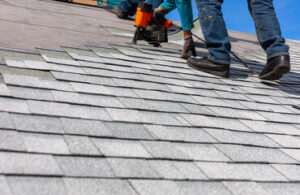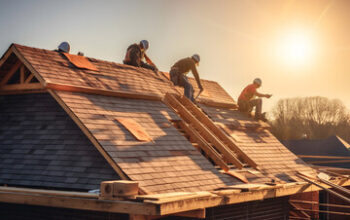Before you get to work on your roof, prioritize safety. Equip yourself with a ladder, fall protection equipment and non-slip footwear. Clear the work area and remove any debris that could interfere with your progress.
Quick repairs like plugging holes and sealing leaks reduce expenses over time. However, a complete replacement prevents future damage, adds value and future-proofs your home against harsh weather. To learn more visit their Website:
Your roof is your home’s first line of defense against the elements, but different weather conditions can take their toll on its durability over time. Regular inspections and prompt repair of any issues are essential for keeping your home safe and comfortable. Understanding what to look out for, such as missing shingles, visible water stains on ceilings and walls, and sagging areas of the roof, can help you catch problems before they become major repair needs.
The most common cause of weather-related damage to a roof is wind and hail. Strong winds can lift and tear shingles, or even blow them off the roof entirely. Torrential rain can also overwhelm drainage systems, causing water penetration that damages insulation and other roof components.
Hail can create severe dents in shingle materials, as well as puncture holes through metal roofing sheets. If left unchecked, such damage can lead to leaks that affect the interior of your home.
Changes in temperature can also contribute to roof problems. Frequent freezing and thawing causes material fatigue that leads to cracks in flashing, or between shingles. This can then expose your roof to water infiltration, which can further deteriorate the structure and allow moisture into the home.
The best way to protect your roof against weather-related damage is through routine maintenance and frequent inspections. Schedule professional inspections at least twice a year and after major storms. Keep your gutters clean and clear of debris that can clog drains, and trim branches that overhang the roof. Also be sure to regularly inspect seals around vents and chimneys, which are often the source of leaks during stormy weather. Using weather-resistant roofing materials and regular maintenance can help you get the most out of your roof, protecting your home against inclement weather and preventing costly repairs in the future.
Damaged Shingles
One of the most common roof repair issues is damaged shingles. This problem can be caused by a number of different factors, including weather fluctuations, age, lack of ventilation in the attic, heavy impact, and general wear and tear. Damaged shingles can leave your roof vulnerable to leaks and other structural damage.
During routine inspections, check for shingle damage, looseness, and other problems that can lead to roof leaks. In addition to examining shingles, pay attention to the flashing around chimneys, vents, and skylights. If you find flashing that is loose or damaged, have it repaired immediately to prevent water from seeping into your home.
Wind is the biggest threat to shingle integrity. Regular maintenance and using shingles that are designed for high winds can help minimize wind damage, but some damage is unavoidable.
Inspect your shingles after a major storm for damage. Look for shingle rips, which are a clear sign that it is time to replace your roof. Shingles can also become creased, which is an indication that they have been weakened by a strong blow or a prolonged exposure to extreme heat.
Hail can dent shingles, and even crack the underlying roof deck. Snow damage is another issue that can cause serious problems, including sagging and collapsing sections of your roof.
In the event of a severe hailstorm, take immediate action to file an insurance claim and arrange for roof repair. Inspect your shingles after the hail storm for dents and rips, as well as granule loss, which can indicate deterioration.
The granules on shingles aren’t just for aesthetics; they protect the asphalt layer from the sun’s harmful UV rays. When enough granules are lost, the shingles will start to degrade and may be left susceptible to leaks. Check your gutters and downspouts for a significant amount of granules that have washed away; this is a sign that it is time to contact your roofer for repairs. A leaking or otherwise compromised shingle can compromise the insulation of your roof, which can increase your energy costs. Be sure to hire a reputable roofing contractor.
Leaks
While some roof repairs are fairly straightforward, such as replacing a few damaged shingles or caulking an area, other repairs can be much more complicated. Leaks, for example, can quickly cause water damage throughout your home if not addressed promptly. Water can also seep into electrical wiring, creating a fire hazard and potentially damaging your home’s insulation.
Oftentimes, water leaks are caused by a broken seal, or flashing, around chimneys, skylights and vents. This is usually the result of poor construction, but sometimes weather can be to blame. In any event, it’s important to have your roof leaks repaired as soon as you notice them to prevent further damage and ensure the safety of your family and pets.
A common sign of a roof leak is water stains on your ceiling. If left untreated, these can lead to mold and mildew, which are not only unsightly but also unhealthy for you and your family. You can also often spot these stains by noticing musty odors in your home.
In order to find the source of a leak, it’s a good idea to have access to your attic. If you do have access, use a garden hose to spray water on your roof, starting at the area where you think the leak is coming from. Allow the hose to run for several minutes in one spot before moving it up to another area of your roof. Keep in mind that it may take more than an hour to locate the source of the leak, so don’t be afraid to buy your helper dinner!
If you don’t have access to your attic, you can look for water stains on the underside of the roof decking or attic insulation. If you’re able to locate the source, it’s a good idea to hire a professional roofer. They’ll be able to replace the faulty flashing and restore your roof’s waterproof protection.
In addition to leaks, you should also check for a sagging roof, which is a telltale sign of structural damage. While you’re waiting for a roofing company to arrive, it’s a good idea to put a tarp over any bulging areas of your roof. If a sagging roof is left to worsen, it can lead to severe damage and even require a full roof replacement.
Sagging
A sagging roof is more than just an eyesore—it’s a warning sign that the structure of your home is under stress. Left unattended, sagging areas may develop further structural damage, and in severe cases, even collapse. This can lead to leaks, mold growth, and other issues that threaten the safety of your family and belongings.
The best way to avoid sagging in the first place is through regular roof maintenance and inspections. These can identify minor problems before they become serious, and prevent the need for expensive repairs. However, when sagging does occur, it’s essential to act quickly to resolve the issue and protect your home.
A professional contractor will be able to assess the damage and recommend appropriate roofing repairs. This may include installing support beams to distribute weight evenly and halt further sagging. They’ll also examine the roof for underlying issues, such as rotting or water damage, and fix any that they find.
Sagging in the middle of a roof is often the result of a broken rafter or truss. This can be difficult to detect from the outside, but a thorough visual inspection is crucial. Start by examining the roof from different angles to look for any obvious dips or unevenness. Then, move inside to the attic and check for signs of damage to rafters and the roof decking.
If a sagging roof is the result of a broken rafter, a simple repair can be made with steel “L” channels and lag bolts. These channels are affixed to the broken truss or rafter and then attached to the adjacent joists with lag bolts. Make sure to use the right tools, including a ladder and protective gear like a hard hat, and work during dry weather.
Whether your roof requires replacement or simply repairs is dependent on the severity of the damage and the age of the structure. Minor sagging in a newer roof may be repaired effectively, but if the problem is more significant or widespread, it might require full replacement. Regular maintenance and inspections are the best way to avoid such an expensive undertaking.

